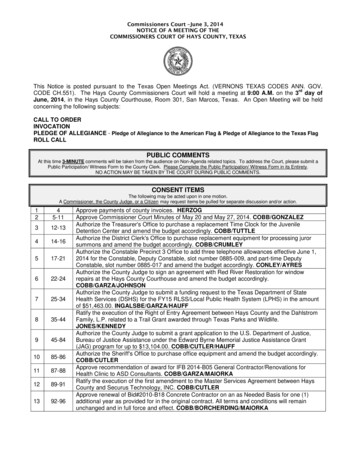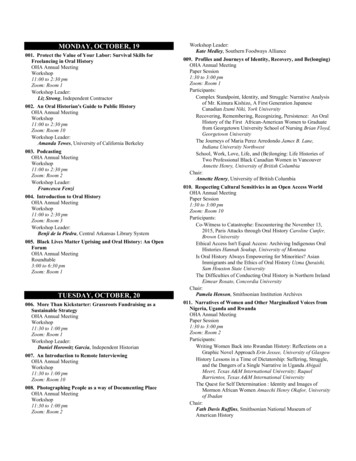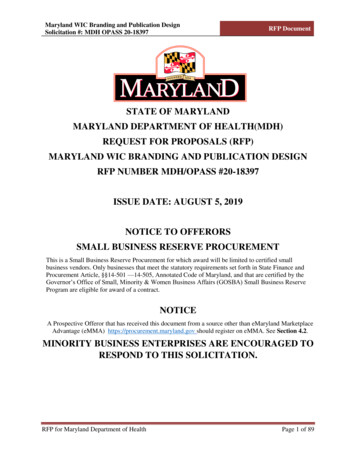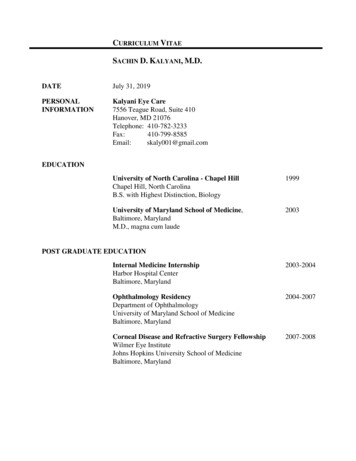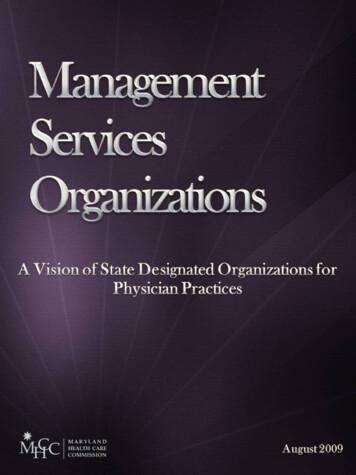
Transcription
CommissionersMarilyn Moon, Ph.D., ChairVice President and Director, Health ProgramAmerican Institutes for ResearchGarret A. Falcone, Vice ChairExecutive DirectorCharlestown Retirement CommunityBarbara Gill McLean, M.A.Retired, Senior Policy FellowUniversity of Maryland School of MedicineReverend Robert L. ConwayRetired Principal and TeacherCalvert County Public School SystemRoscoe M. Moore, Jr., D.V.M., Ph.D., D.Sc.Retired, U.S. Department of Healthand Human ServicesJohn E. Fleig, Jr.DirectorUnited HealthcareKurt B. Olsen, EsquireKlafter and Olsen LLPTekedra McGee Jefferson, EsquireAssistant General CounselAOL, LLCSylvia Ontaneda-Bernales, EsquireOber, Kaler, Grimes & ShriverKenny W. KanSenior Vice President, Chief ActuaryCareFirst BlueCross BlueShieldDarren W. PettyVice PresidentMaryland State and DC AFL-CIOGeneral Motors/United Auto WorkersSharon Krumm, R.N., Ph.D.Administrator & Director of NursingThe Sidney Kimmel Cancer CenterJohns Hopkins HospitalNevins W. Todd, Jr., M.D.Cardiothoracic and General SurgeryPeninsula Regional Medical CenterRobert Lyles, Jr., M.D.Medical DirectorLifeStream Health CenterRandall P. Worthington, Sr.President/OwnerYork Insurance Services, Inc.i
[Intentionally Left Blank]ii
Table of ContentsAbstract . 1Management Services Organizations . 3Key Requirements for MHCC Designation . 5Next Steps . 6Appendix A: MSO Accreditation Categories . 7Organizational . 7Policy . 7Appendix B: MSO Accreditation Organizations . 9Electronic Health Network Accreditation Commission. 9Background . 9Accreditation . 9Criteria . 9URAC . 10Background . 10Accreditation . 10Criteria . 10Managed Service Provider Alliance . 11Background . 11Accreditation . 11Criteria . 11Statement on Auditing Standards: SAS 70 Type II . 12Background . 12Accreditation . 12Criteria . 12iii
[Intentionally Left Blank]iv
AbstractEffective use of health information technology (health IT) can help improve health care quality,prevent medical errors, and reduce costs by delivering essential information at the point of care.Successful health IT requires two crucial components – widespread use of electronic health records(EHRs) and the ability to exchange health information privately and securely. While both arechallenging projects conceptually, technologically, and economically, the implementation of EHRspose special challenges. These challenges mostly relate to the cost of the software and maintainingsystems that support the application. The integration of EHRs into a physician practice takes timeand is influenced by technology constraints, costs, and different perceptions and expectations.Management services organizations (MSOs) have emerged as a way to address these challenges.MSOs are considered a viable alternative to the traditional EHR client-server model where thetechnology is maintained at the provider site. These organizations are capable of supporting multipleEHR products at reduced costs through economies of scale and bulk purchasing. Technical supportusually extends beyond the standard business hours and in some instances is available on a 24/7basis. Data is safeguarded through a network operating center (NOC) that, by design, ensures highquality and uninterrupted service. MSOs enable physicians to access a patient’s record whereveraccess to the Internet exists. EHRs maintained outside of the physician practice enables physiciansto focus on practicing medicine rather than dedicating staff to support the application. On May 19,2009, Governor Martin O’Malley signed House Bill 706, Electronic Health Records – Regulationand Reimbursement, into law. This law requires the Maryland Health Care Commission (MHCC) todesignate one or more MSOs to offer EHRs throughout the state by October 2012.Over the next year, MHCC plans to identify the critical infrastructure requirements for MSOs thatseek a state designation. At a minimum, designated MSOs will need to comply with therequirements of the Health Insurance Portability and Accountability Act of 1996, (HIPAA),Administrative Simplification 1 provisions and conform to the meaningful use requirements in theAmerican Recovery and Reinvestment Act of 2009 (ARRA). 2 The HIPAA requirements establish theframework that MSOs will need to build upon to obtain a state designation. The ARRA establishes aframework for maximizing the use of EHRs in order to receive incentive payments under the Act.To qualify for a state designation, MSOs must offer more than one EHR solution and demonstrate theexistence of robust policies for access, authorization, authentication, and audit. MSOs will need toundergo an independent assessment to validate privacy and security policies and technicalperformance. The MHCC designation will be valid for a three year period. MHCC plans to workwith stakeholders and existing accrediting entities to develop criteria for a state MSO designation.1Department of Health and Human Services, Office for Civil Rights, HIPAA Administrative Simplification. e/privacyrule/adminsimpregtext.pdf 2H.R. 1, 111th Cong., American Reinvestment and Recovery Act of 2009, (enacted), Division A, Title XIII. ?dbname 111 cong bills&docid f:h1enr.pdf 1
[Intentionally Left Blank]2
Management Services OrganizationsManagement services organizations (MSOs) use an application service provider (ASP) to host one ormore electronic health record (EHR) 3 systems through the Internet. MSOs are well positioned toleverage buying power and manage the technical aspect of EHRs, which frequently makes thisapproach favorable among physician practices in their evaluation of EHR systems. 4 This is incontrast to the client-server or standalone model that requires physician practices to individuallynegotiate pricing and maintain the technology required to support the software. The client-servermodel in some locations remains the only option for practices that decide to implement an EHRsystem. Broadband is required to access an MSO and is not universally available to physicianpractices in remote areas. Some places in Western Maryland, on the Eastern Shore, and in SouthernMaryland have limited access to broadband and at the present time could not participate with anMSO.MSOs can be established by multi-stakeholder groups, hospitals, or physician practices 5 that formtogether to offer EHR solutions. Oftentimes, these solutions are in conjunction with other productsand administrative services, most notably practice management systems. The most popular approachto EHR adoption remains the client-server model, where the software and hardware reside locally atthe physician practice. MSOs offer many advantages over the traditional model and the monthlysubscription fees to an MSO is usually less than a client-server model with less upfront costs.Connecting to a health information exchange (HIE) 6 presents less challenges for physician practicesin an MSO model as the MSO can more readily establish and maintain a connection to the exchange.Connecting EHRs to an HIE is a critical step in maximizing the benefits of electronic healthinformation. 7,8 One of the requirements for incentive funding for physicians under the AmericanRecovery and Reinvestment Act of 2009 (ARRA) is being able to demonstrate that their EHR systemis connected to an HIE. 9MSOs provide an alternative for EHR adoption and use network operating centers (NOCs) to host thetechnology. Outsourcing essential administrative and clinical record keeping functions to an MSOhas the potential to reduce a physician practice’s overhead. MSOs provide a consistent way ofmanaging privacy and security and ensuring the existence of robust physical and technical safeguardsof electronic data. 10,11 MSOs are capable of supporting EHR products with different levels of3An EHR is a computerized, longitudinal record of health information that includes clinical decision support and electronicprescribing.4American Academy of Family Physicians, Center for Health Information Technology, Brief Report of the AAFP’s EHR PilotProject: Key Learnings from Six Small Family Practices, March 8, 2005. http://www.centerforhit.org/PreBuilt/chit pilotresults.pdf 5J.C. Robinson, “Physician Organization in California: Crisis and Opportunity,” Health Affairs, Project HOPE: 2001. 20/4/81 .6A statewide HIE is currently under development in Maryland.7Institute of Medicine, Key Capabilities of an Electronic Health Record System, 2003. http://www.iom.edu/?id 19374 .8Healthcare Financial Management Association, Overcoming Barriers to Electronic Health Record Adoption, February 2006. 8-A33F-1512A40F2CC8/0/ehr.pdf .9H.R. 1, 111th Cong., American Reinvestment and Recovery Act of 2009, (enacted), Division A, Title XIII. ?dbname 111 cong bills&docid f:h1enr.pdf 10S. Mason, ASPs are Worth a Second Look, Behavior Health Management, November/December 2003. EBSCOhost database.11California HealthCare Foundation, Creating EHR Networks in the Safety Net, March 2008. ingEHRNetworksInTheSafetyNetIB.pdf 3
sophistication that serve physician practices of various sizes and specialties. In general, MSOs allowfor more advanced reporting, which may be used to help physician practices become more efficientand cost effective. Physician practices participating with an MSO have continuous access to data andtypically receive support beyond core business hours. MSOs are unique in the level of supportservices they provide as compared to the client-server environment where they are often left toresolve problems on their own. 12 MSOs use NOCs to host software and manage the physical securityof the information and the protections related to authorization, authentication, and access. NOCsperform detailed analysis of system safeguards and are capable of providing comprehensive auditlogs.In 2004, the American Academy of Family Physicians’ Center for Health Information Technologyconducted an EHR Pilot Project that was supported by the Centers for Medicare and MedicaidServices. Results of the study demonstrated that EHRs hosted by an MSO provide measurableefficiencies through the centralization of data storage and maintenance. 13 MSOs are becomingincreasingly popular around the nation; California and Florida are examples of two states that useMSOs to drive the adoption of EHRs. 14 MSOs in these two states have managed to build confidencefrom physician practices in using the Internet as a secure and reliable approach for EHR adoption.MSOs function as a Business Associate under the Health Insurance Portability and AccountabilityAct of 1996 (HIPAA) and are required to meet industry defined performance criteria for privacy andsecurity.Existing law requires the MHCC to designate one or more MSOs to offer services throughout thestate by October 1, 2012. Expanding the options for EHR adoption is expected to help spur growthstatewide and enable more physicians to take advantage of the EHR adoption incentives under theARRA. 15 The rate of EHR adoption in Maryland is consistent with national activity, which isreported at roughly 17 to 27 percent. 16,17 MSOs provide a viable solution to the adoption of EHRsand offer a private and secure alternative to the traditional client-server EHR system maintained atthe provider site. MHCC in consultation with select stakeholders intends to develop criteria for statedesignation.12E. Mendoza, “Security Considerations When Choosing An EMR System: Electronic Medical Record Systems Offer ManyBenefits That Can Improve Physician/Patient Interaction and Relationships. In Addition To Saving Time and Eliminating PaperCharts, EMR Systems Provide Numerous Security Capabilities – EMR – EMR Security,” Health Management Technology,October 2003. http://findarticles.com/p/articles/mi m0DUD/is 10 24/ai 109025623/ 13Ibid.14K. Terry, “Can an MSO Help You?” Medical Economics, November 3, 2006. s/Can%20an%20MSO%20help%20you.pdf 15H.R. 1, 111th Cong., American Reinvestment and Recovery Act of 2009, (enacted), Division B, Title IV. ?dbname 111 cong bills&docid f:h1enr.pdf 16M. Goldstein, Physician Adoption of HIT: AHRQ 2007 Annual Meeting, The George Washington University Medical Center:Washington, DC. oldstein/Goldstein.ppt .17D. Gans, J. Kralewski, T. Hammons, and B. Dowd, “Medical Groups’ adoption of electronic health records and informationsystems,” Health Affairs, September/October, 2005. 1323 .4
Key Requirements for MHCC DesignationMSOs offer a cost effective alternative to physician practices that seek to implement EHRs. Theaverage cost of a client-server EHR system is around 53,000 per physician over three years 18 ascompared to the ASP model where the three year average is around 28,800 per physician, or 800per physician per month. 19 An important distinction between the two models is that MSOs usecritical mass to manage costs and implement technology; whereas standalone EHRs require thephysician practice to implement the necessary software and maintain the hardware. MSOs are aviable alternative to the standalone EHR model and have enormous potential to spur adoption. Thelegislature tasked the MHCC with developing requirements for MSOs interested in obtaining a statedesignation. The criteria for a state designation will focus largely on privacy and security,compliance with the ARRA for incentive funding, safeguarding the NOC, and the development ofuser participation agreements that address how electronic data is accessed, stored, and maintained.To be considered for a state designation, MSOs will need to offer more than one nationally certifiedEHR solution that meets the meaningful use definition and has a NOC that conforms to industrydefined technical performance standards.Ideally, MSOs will compete for market share based on their EHR solutions, and other administrativeand practice support services. 20,21 Broad functionality of an EHR is critically important and MSOsseeking a state designation will need to select technology solutions that include at a minimum clinicaldecision support, e-prescribing, computerized physician order entry, and diagnostic results viewing.State designated MSOs will need to integrate hosted EHRs with the statewide HIE as specificfunctionality of the exchange becomes available. MSOs designated by the state will deploy a NOCwith a technical infrastructure that complies with HIPAA’s administrative, physical, and technicalsafeguards. 22 Stringent policies pertaining to access, authentication, and authorization are alsorequired. Established reporting measures related to provider satisfaction and assessing MSOperformance is a critical component of state designation. Gathering physician feedback on EHRsolutions and satisfaction levels with end user support is required on an annual basis. Statedesignated MSOs will need to report select aggregate performance information to the MHCC.The relationship between MSOs and the physician practice is conceptually a simple one.Agreements should be mutually beneficial and flexible to allow for changes in physician practice andin the marketplace. State designated MSOs need to allow physician practices to enter into anarrangement that includes a without-cause termination feature that enables them to terminate thearrangement without a reason after an appropriate amount of time. Consistent with the new HIPAArequirements, the relationship between physician practices and a state designated MSO must include18R. Lowes, How Much Do EHRs Cost? The Latest Data, February 8, 2008. le/articleDetail.jsp?ts 1235141049717&id 488973 19Future Healthcare, Is the Application Service Provider Model the Answer to Physician EHR Adoption? http://www.futurehealthcareus.com/?mc application-service-ehr&page ehr-viewresearch 20Ibid.21IPRO, What Is the Difference Between An ASP and Locally Hosted Models of EHR? 0EHR.pdf 22Extreme Networks, Data Center Network Overview, 2009. /SODataCenter 1552.pdf 5
a Business Associate Agreement. Among other things, data ownership should be specified in theBusiness Associate Agreement. Physician practices need to retain ownership of the data and theMSO will be required to make the data available electronically or on paper at the request of thephysician practice. 23,24 State designated MSOs will not be permitted to withhold patient data pendingany sort of dispute resolution or charge an undo amount for the information.State designation will require MSOs to undergo an independent review every three years of theirprivacy and security policies and technical safeguards. 25 The complexity of the assessment willdepend largely on the size of the MSO and its NOC. MSOs that are state designated must conductintrusion testing and have a disaster recovery plan that is updated annually. The disaster recoveryplan should address policies related to what constitutes a disaster, a physician practice notificationprocess regarding the disaster, and the mechanism for notification. The disaster recovery plan needsto identify critical individuals that can conduct a damage assessment and decide how to mitigate thesituation. State designated MSOs will need a defined process for safely storing off-site back-ups anddetailed procedures for restoring data from back-ups, as well as the identification of a hot site thatcan be operational within a matter of hours.The benefits of an MSO are wide-ranging, in particular, they relieve physicians from the burden ofmanaging information systems required to support EHRs. Implementing EHRs requires a substantialcommitment and willingness of a physician practice to make process changes that impact all levels ofa physician practice. State designated MSOs will need to provide assistance to physician practiceswith planning, implementation, and help in identifying new roles and responsibilities for physiciansand office staff. 26 EHR implementation requires project management, change management withworkflow redesign, and end-user training; state designated MSOs are expected to provide physicianpractices with adequate guidance to ensure successful implementation. The criteria for statedesignation will be developed using stakeholder input to ensure that MSOs adequately addressperformance standards related to privacy and security and technical safeguards.Next StepsPhysician practices often lack the technological infrastructure to support implementingcomprehensive EHRs. For the most part, the cost of implementation and the numerous challenges ofmanaging standalone EHRs are viewed by physician practices as a leading deterrent to adoption. Atrusted alternative approach is essential in order to help spur EHR adoption; the MSO model providesa suitable alternative. MHCC plans to convene a stakeholder workgroup to develop the evaluationcriteria for MSOs that seek a state designation. Engaging stakeholders in establishing performanceexpectations is critical to defining a robust set of criteria that is necessary to ensure privacy andsecurity and technical performance of MSOs that seek a state designation. MHCC plans to developthe criteria for state designation with the help of stakeholders over the next fs/HPTSG Datacenterassessments firststep wp.pdf26A. Schreiber, et.al, The Real Challenge in Implementing EHRs, HCT Project Volume 3, November 14, 2005.246
Appendix A: MSO Evaluation CategoriesThe evaluation criteria for a state designation must consider the organizational structure of the MSOand their approach to implementing key policies. The list below represents leading items forconsideration by the stakeholder workgroup.OrganizationalBusiness Associate AgreementsCertified EHR Software and Meaningful Use ComplianceData OwnershipOperations and Technical PerformanceResourcesSupport tAdministrative SafeguardsPhysical SafeguardsTechnical SafeguardsQuality Reporting7
[Intentionally Left Blank]8
Appendix B: MSO Evaluation OrganizationsMSOs seeking MHCC designation will be required to undergo an independent assessment of theirprivacy and security policies and technical safeguards. MHCC has identified the following threeorganizations, along with an assessment instrument for consideration in evaluating MSOs that storeand maintain data.Electronic Health Network Accreditation CommissionBackgroundThe Electronic Healthcare Network Accreditation Commission (EHNAC), an independent, 501(c)(6)not-for-profit accrediting agency, grew out of the 1993 Workgroup for Electronic Data Interchange(WEDI). The health care transactions industry felt there was a need for a self-governing body todevelop standards for the industry. More than thirty representatives from all facets of the health caretransactions industry participated in development of the standards for data transmission, datasecurity, advertising, and resource capability.AccreditationEHNAC accreditation provides comprehensive and objective business evaluation; drives the use ofbest practices by evaluating business performance against measureable industry criteria; facilitatesbusiness discipline, organization, and planning through self-assessment; formalizes and improvesbusiness processes that are tailored to the specific business environment; improves the quality ofproducts and services; provides training tools for employees; identifies security and business riskexposures and reduces liability; and provides a competitive advantage.CriteriaEHNAC site evaluators use a rating method to determine overall compliance with EHNAC criteria.The site evaluator assigns a pass or fail rating to each activity in the criteria, based upon anapplicant’s ability to demonstrate compliance. The accreditation criterion focuses on privacy andconfidentiality, technical performance, business practices, resources, and security. 2727All information obtained from EHNAC’s website. http://www.ehnac.org/ 9
URACBackgroundURAC is an independent organization initially established with a mission to improve the quality andaccountability of health care organizations using utilization review (UR) programs. The industry’sconcerns over the lack of uniform standards for UR services were the key reasons URAC wasestablished. URAC has grown to over 16 accreditation and certification programs and covers a largerange of service functions found in various health care settings. The governing Board of Directors iscomprised of representatives from all affected constituencies: consumers, providers, employers,regulators, and industry experts.AccreditationURAC accredits many types of health care organizations, which depends on the organization’sfunctions. URAC has a number of different accreditation programs, some that review the entireorganization, such as the health plan standards, and others that focus on quality within a singlefunctional area in an organization, such as case management or credentialing. Any organization thatmeets the standards, including hospitals, HMOs, PPOs, TPAs, and provider groups, are eligible toseek accreditation.CriteriaThe standards vary by program and those assessed for privacy and security include: implementationof a privacy compliance plan; maintenance of policies and procedures; requirements for businessassociates; workforce training; notice of privacy practices; rights of individuals; authorizations; usesand disclosures; complaints; and special requirement for hybrid entities, among other things. 2828All information obtained from URAC’s website. http://www.urac.org/ 10
Managed Service Provider AllianceBackgroundThe Managed Service Provider (MSP) Alliance is a professional association and accrediting body forthe managed services industry. MSP Alliance was created by service providers almost 10 years agoto meet the needs of the managed services professional as well as the vendor and business consumer.MSP Alliance enforces a strict code of ethics for its members to assure standards for the informationtechnology business consumer. The MSP Alliance is made up of over 8,000 providers world-wide.These providers work together in a vendor-neutral manner to define and promote the managedservices industry by educating consumers on the benefits of using managed service providers.AccreditationThe MSP Alliance is the only professional association, accrediting body, and standards based bodystrictly dedicated to the managed services industry. The MSP Alliance offers its members extensiveeducational courses in the Managed Services Institute, world-wide networking with over 9,000 peers,and holds the only vendor agnostic, purely MSP created accreditations and certifications in themanaged services industry.CriteriaThe accreditation criteria for MSP Alliance are not publicly available. 2929All information obtained from MSP Alliance’s website. http://www.mspalliance.com/ 11
Independent Audit – Statement on Auditing Standards: SAS 70 Type IIBackgroundStatement on Auditing Standards, or SAS 70, is an auditing statement developed by the AmericanInstitute of Certified Public Accountants (AICPA). SAS 70 is designed to allow auditors to reviewthe controls established by service organizations. Independent auditors review the control objectivesand activities to ensure the controls are valid and enforced. These controls are used to ensure that theorganization is in compliance with their established policies and procedures. SAS 70 Type II auditsfocus on the controls that are in place, as well as how they are executed over a six month period.AccreditationA service organization can issue a copy of the SAS 70 Type II audit report to user organizations toverify that the processes and procedures (controls) are adequate for the organization. Ongoing SAS70 Type II audits ensure the organization is keeping its policies and procedures up to date astechnology and business needs change. As these audits are performed by independent auditors, thisensures the service provider is continuing to create and implement proper controls.CriteriaThe criteria provide an overview of guidelines for areas of control. These controls include, and arenot limited to, overview of operations; relevant aspects of the control environment, risk assessment,and monitoring; information and communication; control objectives and related controls; user controlconsiderations; control objectives, related controls, and tests of operating effectiveness. Specificcontrols could include building access/security, datacenter access/security, data storage, customerinformation security, and change
Expanding the options for EHR adoption is expected to help spur growth statewide and enable more physicians to take advantage of the EHR adoption incentives under the ARRA. MSOs in these two states have managed to build confidence from physician practices in using the Internet as a secure and reliable approach for EHR adoption.

